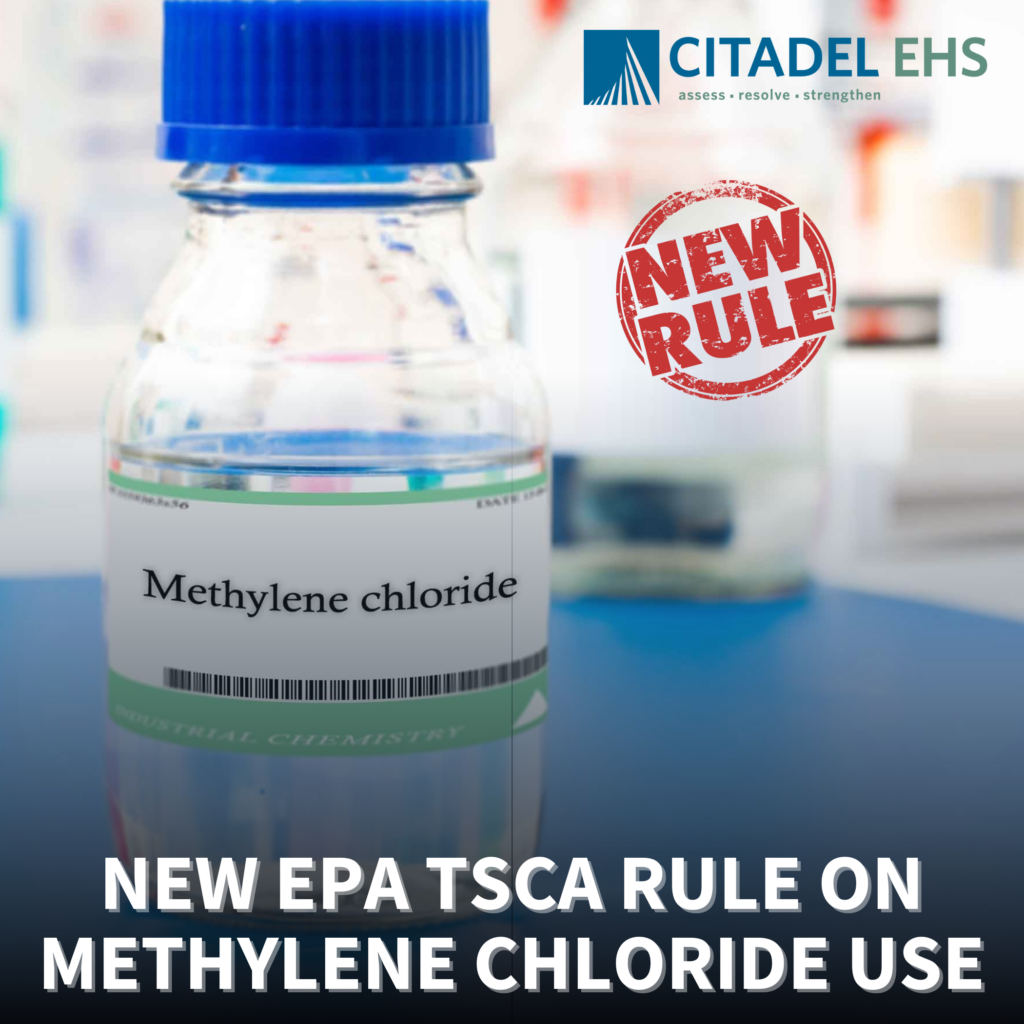
The Environmental Protection Agency (EPA or the Agency) has finalized a rule to address the occupational health risks presented by the use of methylene chloride use. Methylene chloride is a chlorinated organic solvent commonly used in commercial and industrial purposes due to its useful properties. Common uses include paint strippers and coating removal, adhesives, pharmaceutical manufacturing, and polyurethane foam production, and chemistry reagent for chemical reactions, extractions, and purifications. Although it has useful properties, exposure to methylene chloride presents a health hazard due to its toxicity and carcinogenicity. Due to this health hazard, the new EPA rule creates new requirements intended to prevent illness associated with uncontrolled exposures to methylene chloride chemical by:
- preventing consumer access
- restricting industrial and commercial uses
- protecting workers from unsafe occupational exposures to methylene chloride
Workplace Chemical Protection Program
The EPA rule is similar in some respects to existing regulations under Federal OSHA and Cal/OSHA, requiring exposure monitoring and exposure controls, but it adds the requirement of a written workplace chemical protection program (WCPP). The WCPP includes inhalation exposure concentration limits which are significantly lower than the exposure limits established by Federal OSHA and Cal/OSHA.
A WCPP is required for operations that fall within the 13 permitted uses, or “conditions of use” of methylene chloride. Those permitted uses include construction, manufacturing, processing, laboratory use, and disposal. The rule also applies to pharma and research and development work for which there are not always suitable substitutes for methylene chloride.
A WCPP encompasses inhalation exposure thresholds, includes monitoring and recordkeeping requirements to verify that those thresholds are not exceeded, and may include other components, such as dermal protection, to ensure that the chemical substance no longer presents unreasonable risk. Under a WCPP, owners or operators have some flexibility regarding how they prevent exceedances of the EPA exposure limit thresholds but the rule requires the use of the hierarchy of controls (elimination, substitution, engineering controls, administrative controls, and work practices, and finally PPE ( i.e., respirators) as the last resort for controlling inhalation exposures.
Industrial and Commercial Use as a Laboratory Chemical
This condition of use refers to the industrial or commercial use of methylene chloride in a laboratory process or in specialized laboratory equipment for instrument calibration/maintenance chemical analysis, chemical synthesis, extracting and purifying other chemicals, dissolving other substances, executing research and development, and use as a solvent, reagent, or analytical standard for experimental procedures. Laboratory use differs from industrial production use in that the quantity is typically much smaller. For the purposes of this rulemaking, EPA emphasizes that industrial and commercial use of methylene chloride as a laboratory chemical applies to research, government, and academic institutions, as well as to industrial and commercial laboratories.
EPA rule requirements are to begin taking effect on May 5, 2025 for the private sector, with other compliance deadlines scheduled through 2027:
Compliance Deadlines
| Entity Type | Perform Initial Monitoring | Prevent Exposure Exceedances | Implementation of Exposure Control |
| Private Sector | May 5, 2025 | August 1, 2025 | October 30, 2025 |
| Federal Agency | November 9, 2026 | February 8, 2027 | May 10, 2027 |
| Federal Contractor | November 9, 2026 | February 8, 2027 | May 10, 2027 |
Chemical Exposure Limits
| Action Level
|
8-hour TWA
(EPA-ECEL, OSHA-PEL, or ACGIH-TLV)
|
15-min STEL
|
|
| EPA | 1 ppm | 2 ppm | 16 ppm |
| OSHA | 12.5 ppm | 25 ppm | 125 ppm |
| ACGIH | NE | 50 ppm | NE |
ECEL = Existing Chemical Exposure Limit
PEL = Exposure Limit Permissible
STEL = Short-Term Exposure Limit
TLV = Threshold Limit Value
NE = Not Established
Citadel EHS Can Support Your TSCA Compliance Needs
Citadel EHS offers comprehensive industrial hygiene services to support compliance with the EPA’s TSCA rule on methylene chloride. We specialize in devising and conducting exposure assessments that include both full-shift and short-term personal air sampling in accordance with NIOSH and OSHA methods. Samples are analyzed by AIHA-accredited laboratories and results are evaluated against the EPA’s Existing Chemical Exposure Limits (ECEL), Short-Term Exposure Limits (STEL), and applicable Cal/OSHA Permissible Exposure Limits (PEL). As required by the rule, Citadel also assists in creating and implementing exposure control plans that are appropriate to the use case and are based on the hierarchy of controls. Control plans may include state of the art ventilation control measures to ensure that compliance with the low exposure limits is consistently attained. Additionally, Citadel can develop compliant Workplace Chemical Protection Programs (WCPPs) that include exposure monitoring, reporting protocols, and control strategies. Our deliverables are reviewed and certified by Certified Industrial Hygienists (CIHs), ensuring your organization is fully prepared to meet TSCA compliance requirements from initial assessment through program implementation.
